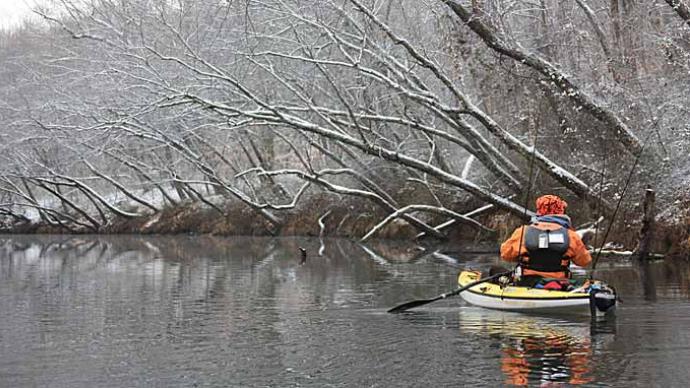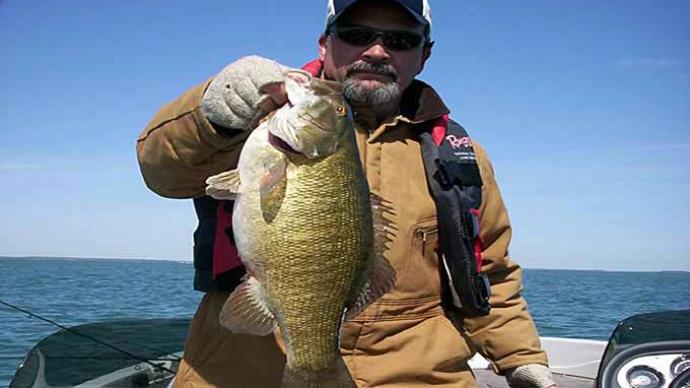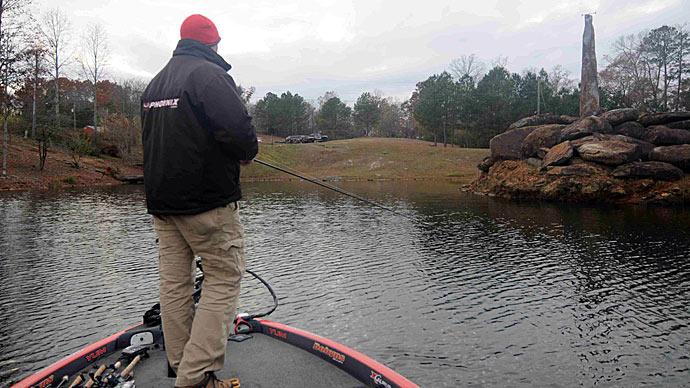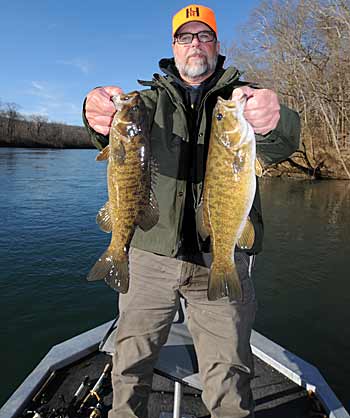
If Bill Smith can launch his boat, he will chase after river smallmouth bass all winter long.
Snow- or ice-covered roads are the biggest obstacles Smith encounters during the winter when he wants to fish for smallmouth bass on the Current River in the Missouri Ozarks. Smith knows if he can trailer his boat to the river, he will have access to the fish because the current and springs flowing into the river keep the stream ice-free throughout the winter.
The Missouri guide braves the cold because he knows where to find the smallmouth; most of the time, he will have little to no competition on the river. During a recent two-day January outing with Smith, he and I fished 25 miles of the current, and we saw only one other boat on the river. “I just love being out on the river in the wintertime. It is so different and refreshing,” said Smith, the Scenic Rivers Guide Service owner in Eminence, Mo.
Wintertime smallmouth in the river are easier for Smith to target because the fish tend to congregate in specific locations. “As winter gets here, the water temperature is dropping (it was 46 degrees when we fished), and the smallmouth’s metabolism slows down, so the fish start moving to the winter holes—deeper water where the current is slower—and that is where they will tend to school up,” Smith said.
The prime wintering spots for river smallmouth are any indentions in the river bottom or holes 15 to 18 feet deep. An essential winter sanctuary for smallmouth is anywhere the river bumps up against a bluff. If the river is gin clear, Smith frequently looks for shade over the deep holes where the smallmouth are less spooky than the fish in the sunshine.
Smith’s favorite time to fish the river is after a winter rain raises the river level and the flushed water becomes stained. During this time, the smallmouth will move up from the deep holes to shallower water but will still be close to the deep structure. The current will be stronger then, so Smith looks for any current breaks, such as logs or rocks, where the smallmouth will be holding in the slack water at depths ranging from 6 to 15 feet. The most productive spots during the two days we fished were in eddies or seams in the current around rocks and wood 5 to 10 feet deep.
Cloudy days are best for Smith on the river, although we caught most of our fish in the sunshine during late morning and throughout the afternoon. Smith also likes a west wind best and an east wind the least. The river expert has also done well fishing in snowstorms. “I have been out on the river when it was snowing so hard while I was running I could hardly see the front of my boat, but the fish were biting,” he said.
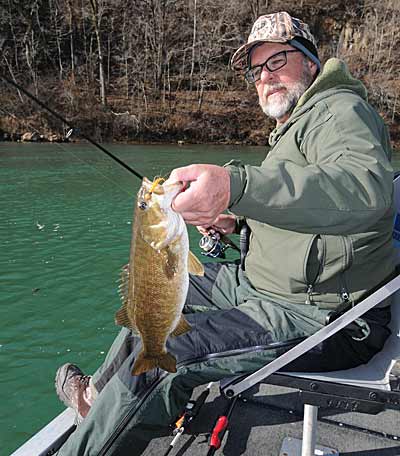
Lure selection is narrowed down to a handful of baits for Smith in the wintertime. His favorite wintertime smallmouth lure is a 1/4-ounce homemade bucktail jig with a thin, short hair skirt in olive green and light or dark brown hues. He also likes to throw 3-inch Bass Pro Shops Stik-O worms and 3- or 4-inch Senkos in brown, purple and green colors rigged Texas style with 1/8- or 1/4-ounce worm weights or attached to Slider jigheads. If the river is high and stained, Smith also catches some hefty wintertime smallmouth on a crawfish-colored crankbait. I caught most of my fish during our outings on a 1/8-ounce Z-Man Power Finesse ShroomZ Jighead with a Z-Man Finesse TRD worm in the New Money or Canada Craw colors.
When fishing the jig or soft plastic baits, Smith makes a long cast at a 45-degree angle and lets the lure swing around in the current until it hits bottom. His retrieve consists of popping the lure to lift it off the bottom and then letting it sink to the river floor again. “I have seen times too when I needed to drag it along a sandy bottom and just pull and let it fall,” Smith said.
The clear water causes Smith to scale down to light line and spinning tackle for most of his wintertime tactics. He opts for 6-pound fluorocarbon line and a 7-foot spinning rod with medium power and extra fast action tip combined with a Pflueger 200 series spinning reel for working his jig and small soft plastics.
Smith notices he usually catches bigger smallmouth in the winter than during the summer because the fish fattened up while feeding heavily in the fall. Lake smallmouth bass tend to be bigger than their river cousins, so big fish on Missouri Ozark streams are typically 18 to 21 inches long. Some of the bigger river fish Smith has caught in the winter have weighed 4 to 4 1/2 pounds and measured 20 to 21 inches.
Numbers of smallmouth can also be caught on the river during the winter. “I have seen days when two good fishermen will catch 75 to 100 fish,” Smith said. “We may catch several small to medium size fish then.” We fished about four or five hours each day, and I caught 15 smallmouth the first day and 12 the next day, with about a 2 1/4-pounder being my heaviest fish. Smith caught around 20 fish each day, with some bass in the 16- to 19-inch range.
Smith notices the winter pattern on the river starts changing in March when the water starts warming and the length of daylight increases prompting smallmouth to move out of the deep holes for their prespawn stage.
BassResource may receive a portion of revenues if you make a purchase using a link above.


